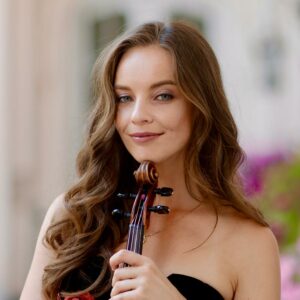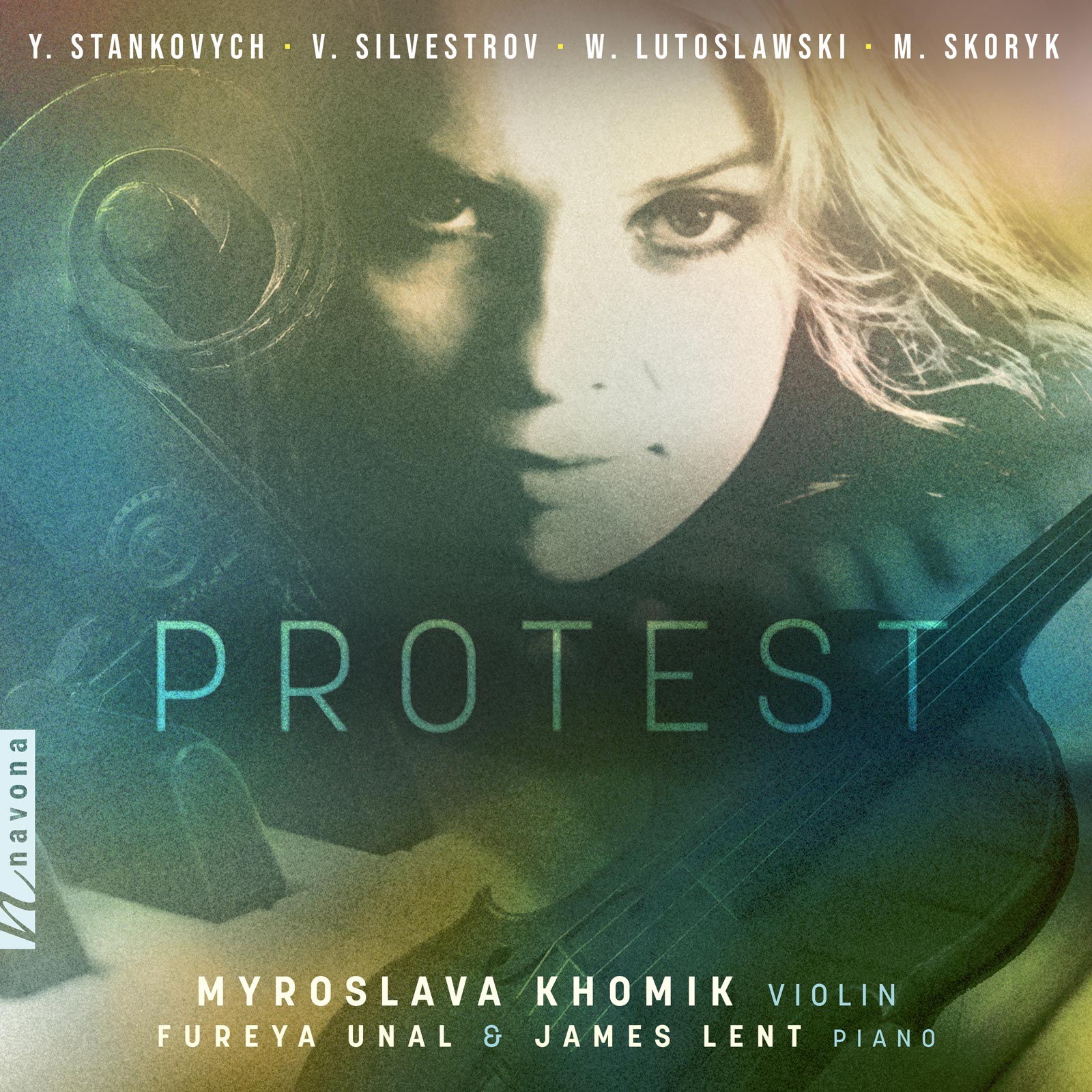Protest
Yevhen Stankovych composer
Witold Lutosławski composer
Valentyn Silvestrov composer
Myroslav Skoryk composer
Myroslava Khomik violin
Fureya Unal piano
James Lent piano
Ukrainian violinist Myroslava Khomik highlights the eternal power of standing for freedom and defiance against oppression in PROTEST, an album featuring the music of four key representatives of 20th century composers from Ukraine and Poland. Expressing strength and resilience through the beauty and search for truth, PROTEST taps into the spiritual essence of human existence and vigilance in the midst of its disruption.
This music is equally representative of the nation’s history of suffering and protest, as well as it is timely in the world of today.
Listen
Stream/Buy
Choose your platform
Track Listing & Credits
| # | Title | Composer | Performer | |
|---|---|---|---|---|
| 01 | Ukrainian Poeme | Yevhen Stankovych | Myroslava Khomik, violin; Fureya Unal, piano | 8:43 |
| 02 | Partita for Violin and Piano: I. Allegro Giusto | Witold Lutosławski | Myroslava Khomik, violin; James Lent, piano | 4:20 |
| 03 | Partita for Violin and Piano: II. Ad Libitum | Witold Lutosławski | Myroslava Khomik, violin; James Lent, piano | 1:35 |
| 04 | Partita for Violin and Piano: III. Largo | Witold Lutosławski | Myroslava Khomik, violin; James Lent, piano | 6:13 |
| 05 | Partita for Violin and Piano: IV. Ad Libitum | Witold Lutosławski | Myroslava Khomik, violin; James Lent, piano | 0:49 |
| 06 | Partita for Violin and Piano: V. Presto | Witold Lutosławski | Myroslava Khomik, violin; James Lent, piano | 4:13 |
| 07 | Post Scriptum Sonata for Violin and Piano: Largo-Allegro-Allegretto | Valentyn Silvestrov | Myroslava Khomik, violin; James Lent, piano | 10:15 |
| 08 | Post Scriptum Sonata for Violin and Piano: Andantino | Valentyn Silvestrov | Myroslava Khomik, violin; James Lent, piano | 4:34 |
| 09 | Post Scriptum Sonata for Violin and Piano: Allegro Vivace | Valentyn Silvestrov | Myroslava Khomik, violin; James Lent, piano | 4:19 |
| 10 | Sonata for Violin and Piano No. 1: Andante-Allegro Molto-Andante-Largo e Grave | Myroslav Skoryk | Myroslava Khomik, violin; James Lent, piano | 6:16 |
| 11 | Sonata for Violin and Piano No. 1: Largo | Myroslav Skoryk | Myroslava Khomik, violin; James Lent, piano | 2:51 |
| 12 | Sonata for Violin and Piano No. 1: Allegro Molto-Andante-Allegro Fantastico | Myroslav Skoryk | Myroslava Khomik, violin; James Lent, piano | 6:18 |
Recorded June 6-7, 2015 at the UCLA Herb Alpert School of Music, Jan Popper Theater in Los Angeles CA
Session Producer & Engineer Laszlo Mezo Productions
Editing & Mixing Laszlo Mezo
Executive Producer Bob Lord
A&R Director Brandon MacNeil
A&R Danielle Sullivan
VP of Production Jan Košulič
Audio Director Lucas Paquette
VP, Design & Marketing Brett Picknell
Art Director Ryan Harrison
Design Edward A. Fleming, Morgan Hauber
Publicity Aidan Curran
Artist Information

Myroslava Khomik
Ukranian violinist Myroslava Khomik brings her love of music-making not only to the prestigious concert halls and festivals around the world, but also to the curation and collaboration of multimedia projects. Known for her “virtue of musical sensitivity and beautiful emotion” (Saigon Times), Khomik is passionate about innovative programming, mixing different art forms, and looking for depth beyond creative expression. She regularly participates in premieres of new works, and initiates new commissions inspired by the subjects she feels are particularly important in today’s world. After her tour in South America in 2018 presenting an all-Ukrainian composers program, Khomik was awarded a New Artist of the year prize in Buenos Aires, Argentina, and was featured on various TV and radio broadcasts in the United States and abroad.

Füreya Ünal
Füreya Ünal was born in Istanbul where she started playing the piano at the age of 3. Her formal music education began when she was 5 years old at Istanbul University State Conservatory. In 1996, Ünal was granted her bachelor’s degree from Istanbul Conservatory. She has also been awarded two masters degrees. Her first masters was granted from Istanbul Conservatory, her second from the Hochschule für Musik und Darstellende Kunst Frankfurt am Main.

James Lent
Pianist James Lent has been on the faculty of the UCLA School of Music since 2009 where he is the head of Collaborative Piano serving as Continuing Lecturer, teaching Piano Literature and Collaborative Piano. He is also on the Principal Music Faculty at the American Musical and Dramatic Academy in Hollywood where he is the head of collaborative pianists, directs music, and coaches vocalists.
Notes
The idea of PROTEST as an album was born during the “Maidan” protests in Kyiv in 2014 — the time we now consider as the start of modern Ukraine’s stance for its freedom from the centuries of its brutal neighbor’s oppression — the epic fight for democracy and peace in the 21st century. The music I chose here was a personal way of expressing all of the feelings many of us were trying to communicate at the time with the surrounding world: a cry out for attention to the horrific developments, and the Ukrainian people’s attempts to prevent more devastation from happening. Seeing the violence against innocent people standing up for their culture, history, and peace in their homeland, is a heart-wrenching sight. Yet, the disbelief and almost paralysing horror of the full-scale war and genocide being committed in Ukraine today, became a global tipping point. Several years after crafting this album, its official release today is quite symbolic as well as cathartic.
Music of the 20th century from the Eastern Bloc was one of the very few resources for expression of thought and opinion, yet significantly powerful. Artists and creatives were often deemed as “enemies of the people” and feared government dictatorship in every aspect of their work. The ever perfecting ways of censorship and silencing of the outspoken knew no limits.
In this thematic deep dive the music speaks more truth than any words could express. It sheds light on the struggle, resilience, and hope of survival after the most vicious atrocities against humanity of this time period. This music is equally representative of the nation’s history of suffering and protest, as well as it is timely in the world of today.
The three leading 20th century Ukrainian composers — Yevhen Stankovych, Valentyn Silvestrov and Myroslav Skoryk — represent a culture and history close to my heart. Coming from different regions and compositional schools in Ukraine, together they have been shaping and continually inspiring the new direction of Ukrainian music and its independence from the historical shadows of previous eras. They each draw on their predecessor’s experiences and discoveries as well as pioneering their new unique and individual styles.
The fact that Ukraine is not the only nation victimized by the Soviet regime deserves significant attention. Witold Lutoslawski, Polish by heritage and largely expressing the pride of his people standing for freedom, is essentially a spiritual brother to any of the composers who fearlessly suffered for the same values. His music embodies the idea of unity in this kind of protest.
Each of the pieces highlight a unique way of expressing the strength and resilience of standing against oppression, violence, and attempt to silence human freedoms — while reminding the listener of the contrasting ideals of beauty, peace, and spiritual essence of human existence in the midst of its disruption.
— Myroslava Khomik

